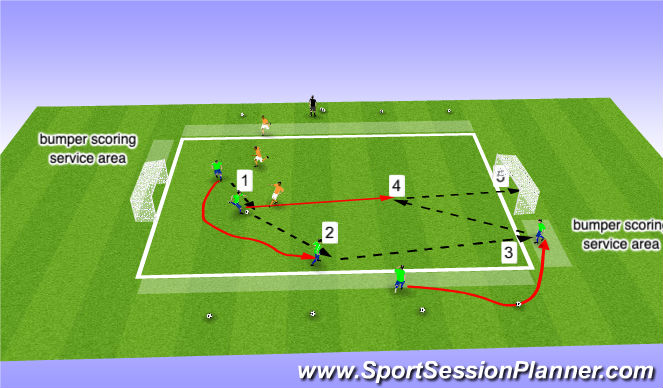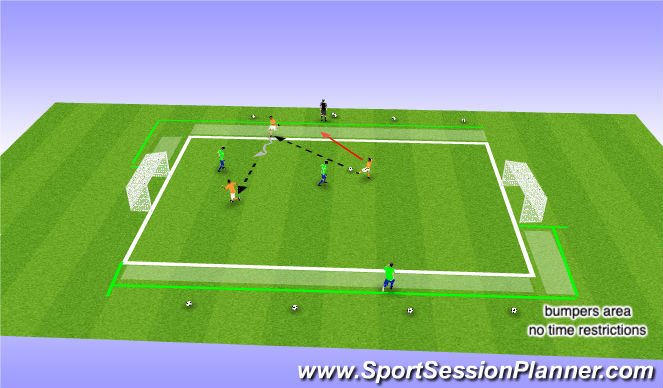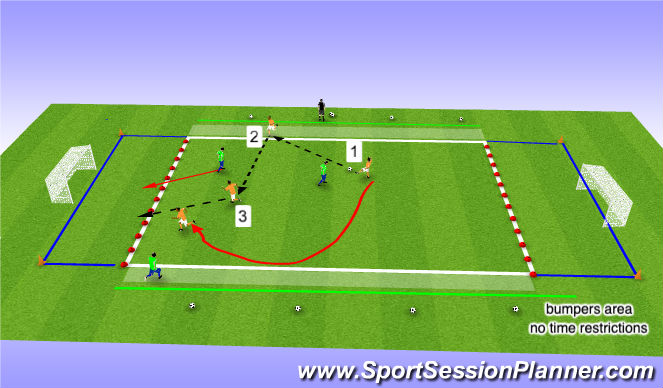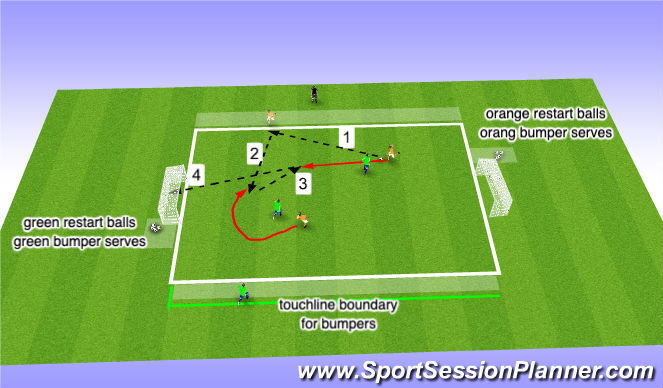Football/Soccer Session (Moderate): Triangles & Bumpers: 4 Progressions
Profile Summary

| Name: | Ken Novak |
|---|---|
| City: | Mitchell |
| Country: | United States of America |
| Membership: | Adult Member |
| Sport: | Football/Soccer |
Description
Tactical decision-making in a 3v2 situation, occurs frequently on the pitch. This small-sided game with four progressions is an uptempo activity that requires a significant amount of cognitive energy: focus, anticipation, and visual cue interpretation.

See the guidance at the top of this page to understand why you are not seeing interactive Football/Soccer images.

Scoring from Goalline service (10 mins)
PROGRESSION #2:
New Condition -- To score, bumpers must serve scoring attacker from the goalline.
Move the restart balls to behind the touchline bumper's lanes.
Coaching points:
-- We are looking to play forward, to drop, to score
-- Again, WE ARE LOOKING TO PLAY FORWARD
-- We don't just play possession for the sake of keeping the ball, we must look always toward penetrating. This new condition emphasizes the need to get the ball up the field.
-- as depicted above, encourage your attacking players to overlap, lay off, or even do take-overs with the main objective, to create enough space to find the bumper on the goal line
-- bumpers: cherry-picking at the goal-line does not help with possession and counters. Coaches can impose a five-second in the zone limit, forcing the bumper to return to their touchline lanes.
-- bumpers: visual cue is HUGE! Bumpers must read when off-the-ball movements are setting up that forward pass to the service area. Again, bumpers are unmarked, therefore, they should devote their mental energy to creating the optimal next situation.
-- coaches: you may tend to focus on the 2 v 2 in the grid, but you should get-after the bumpers for engaging the game. In the real game, 7/11's (wingers) or (6/8/10) midfielders who remain stagant, and not thinking one step ahead continually botch opportunties.
-- Continuing from progression #1, the assymetrical use of the field has advantages and disadvantages for both offense and defense. Defense needs to force the ball away from the offensive bumper touchline so as to avoid quick longintudinal passes. If the offense has to find their bumper on a long diagnol pass, it may give enough delay for the defense to react.

See the guidance at the top of this page to understand why you are not seeing interactive Football/Soccer images.

Bumper Exchange (10 mins)
PROGRESSION #3
Bumper Exchange
New Condition: When a bumper is played, he enters the grid and the passing player becomes bumper.
New Condition: No restriction on how goals may be scored.
Coaching Points:
-- now we are truly "rotating the diamond/triangle"
-- off-the-ball movements have added a new dimension, with bumpers becoming a penetrating threat not because of passing, but active presence and dribbling.
-- mental training: our mind shuts off during natural-stoppages or when we think we are safe from active play. In this small-sided game, no participant is ever out of active play
-- Watch your players. See if they lose focus when they get to "rest" as a bumper.
-- The second you notice the "rest" bumper mentality, bring it to your players' attentions.
-- We don't stop working. We don't stop thinking.
-- Soccer physics -- Space = time. Time = quality. Back to fundamentals. Has our first touch diminished with the pace of the game, with our fatigue, with our lack of forward thinking. Bumpers are still "unmarked" and therefore should still have the ability to have the quality first and second touches necessary to keep together a chain of successful passes. Our grid players must create the first element -- space -- with their first touch.
-- Back to fundamentals: first touch = surface + direction + distance.
-- Bumpers have the L-shaped run outside the grid. No restrictions on where they can be or for how long.

See the guidance at the top of this page to understand why you are not seeing interactive Football/Soccer images.

Offsides and Penetrating Runs (10 mins)
PROGRESSION #4 -- Offsides & Penetrating Runs
New Condition: 5 yard endzone are added to original grid
New Condition: No player, offense nor defense may enter into the endzone EXCEPT to run on to a through ball. The endzone line demarcates an "offside line" held by some unseen defender.
New Condition: Bumpers and grid players may exchange positions at their verbal or visual commands. Just because a grid player passes to the bumper, the grid player is not obligated to leave the grid to become a bumper (as shown in the diagram above).
Once the ball has been played into the endzone, any player may enter the endzone to attack or defend.
Coaching Points:
-- timing our runs, but also training our minds and eyes to see the penetrating opportunity.
-- too often players will stall out in the attacking third, seeing more obstacles that are truly present. this progression works to to encourage boldness, to attack the back line and to break through
-- the added condition of voluntary bumper replacement makes communication so key.








 Play animation
Play animation Play step-by-step
Play step-by-step Repeat (toggle)
Repeat (toggle) Full Screen
Full Screen Pause
Pause Stop
Stop
Wing Bumpers (10 mins)
-- 2 v 2 with bumpers
-- play 3 minutes, then rotate bumpers in
-- no gk's, no offsides
-- restarts happen with bumpers who inbound ball with kick from goal line
(then move quickly back to touchline)
PROGRESSION #1 --
Coaching Points
1) Explain upfront what you are looking for...
a) on offense it is always 3v2, because the bumpers stay unmarked on one side
b) emphasize the importance of scanning before first touch: "if I get it, what's next?" is the mantra
c) speed of thought is speed of play -- coach is looking for not just technical skill, or taking on a defender, but tactical decision-making that uses a numbers-up scenario.
d) defense is outnumbered, therefore quick, controlled pressure forces the first attacker to become a "ball-watcher" and closes down tactical options
e) "play behind the fence" - make crescent runs behind the defender, splitting his attention between the first attacker and his mark who just went upfield and behind him.
f) "play to the space" when "playing behind the fence" -- second attacker needs to give visual cue where he wants the ball played
g) bumpers must work! bumpers must be the outside point of the triangle, going flat for a safe pass, or finding a seam for a through ball.
h) bumpers (unmarked) must focus their mental energy, one pass ahead. If you can deliver the ball with one-touch, don't take two.
i) deepest attacker must have the "forward thought": (receive the drop then shoot).
j) defense: use your bumper's touchline as an advantage to your pressure. Angle of approach for defense is critically important.
Coach's input:
"Can we get the ball behind the defenders?"
"3v2, someone is on! Who is on?"
"Are we moving after we pass the ball?"
"In your head repeat - 'If I get it, what's next?'"
"Defense, close quickly! Make the attacker a ball-watcher"
"Defense, can we force them away from their bumper?"